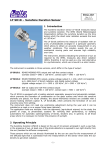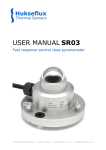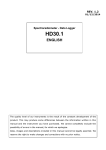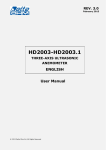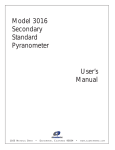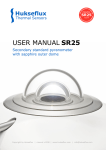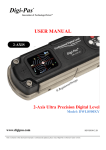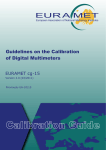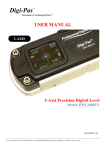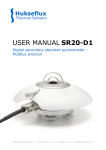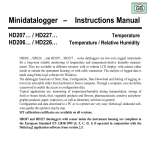Download LP SD18 - Delta Ohm S.r.l.
Transcript
LP SD18 [ GB ] Sunshine duration sensor [ GB ] Description [ GB ] The Sunshine Duration sensor LP SD18 measures sunshine status and duration. The WMO (World Meteorological Organization) defines the sunshine duration as the time during which the direct solar radiation exceeds the level of 120 W/m2. The LP SD18 performs the measure of radiation with an array of photodiodes arranged in a particular geometry which allows to obtain an accurate measurement in any weather conditions. This solution avoids the use of mechanical moving parts and ensures high reliability over time. The instrument, besides indicating the presence of sun as required by the WMO, measures also direct radiation (SRD), therefore it can be used as a low cost alternative to a pyrheliometer, which use is bound to a solar tracker. The instrument is available in three versions, which differ in the type of output: LP SD18.1 RS485 MODBUS-RTU output and volt-free contact output (contact closed = SRD ≥ 120 W/m2, contact open = SRD < 120 W/m2) LP SD18.2 RS485 MODBUS-RTU output, analog voltage output 0…1 Vdc, which corresponds to 0…2000 W/m2 of direct radiation, and digital output voltage (digital voltage output: 1V = SRD ≥ 120 W/m2, 0V = SRD < 120 W/m2) LP SD18.3 SDI- 12 output and volt-free contact output (contact closed = SRD ≥ 120 W/m2, contact open = SRD < 120 W/m2) The LP SD18 is equipped with a separately heating element powered and galvanically isolated, which prevents the formation of condensation on the glass surface onto which the sensitive elements are placed. For harsh climates, the above-mentioned versions are available with a second heating element (option R, LP SD18.xR), which prevents the formation of ice and prevents snow from settling. The instrument does not need any positioning adjustment during the year and it can be installed on a mast or on a proper fixing base (optional). The application fields are multiple: from the agronomy (agricultural science) to the study the growth of crops, to photovoltaic systems for verifying their performance, to building automations for automatic opening/closing of blinds, shutters and, in general, to all those areas where it is necessary to monitor the presence of sunlight. Operating Principle The Sunshine Duration LPSD18 is based on the use of 16 sensors arranged in such a way that, in the presence of sun, at least one of the photo-detectors is exposed to sun light directly from the sun (besides the diffusion component). Those sensors which are not directly illuminated by the sun are used for the measurement of the diffused light that is subtracted from the measurement of the sensor which sees the sun directly, to get direct radiation. The cylindrical glass protects the sensors and the internal circuits of the instrument from the weather and at the same time provides an excellent transparency to sunlight. In order to avoid the formation of condensation inside the instrument, in addition to the heating element, the LPSD18 is supplied with a cartridge that must be loaded with desiccant material in colloidal silica (Silica-gel). Technical specifications Sensitive elements Spectral range Direct radiation SRD measuring range Accuracy of the measurement of direct radiation Accuracy of the measurement of the sunshine duration sensor Response time Threshold value Sunshine duration resolution Power supply Consumption Heating system Anti-condensation device consumption Antifreeze device consumption Internal temperature Measuring range Accuracy Operating temperature Weight Protection degree Outputs LP SD18.1 LP SD18.2 LP SD18.3 16 Silicon photodiodes 360…1100 nm 0…2000 W/m2 Better than 90% on the monthly total Better than 90% on the monthly total <1 second 120 W/m2 1 sec 7…30 Vdc 5mA @ 12V 12…15 Vdc 1W @ 12V 5W @ 12V ON for internal Temp. < 6 °C, OFF for internal Temp > 10 °C -40…+80 °C ± 0.5 °C -40…+80 °C 0.9 kg IP66 • RS485 MODBUS-RTU • Galvanically isolated contact closed = SRD ≥ 120 W/m2 open = SRD < 120 W/m2 • RS485 MODBUS-RTU • Analog output 0…1V (0…2000 W/m2) Digital output 0…1V 1V = SRD ≥ 120 W/m2 0V = SRD < 120 W/m2 • SDI-12 • Galvanically isolated contact closed = SRD ≥ 120 W/m2 open = SRD < 120 W/m2 Installation of the sunshine duration sensor The sunshine duration sensor should be installed in a place easy to be reached for the periodical cleaning of the glass and the maintenance. At the same time, it should be avoided that buildings, trees or obstructions of any kind exceed the horizontal plane on which the sunshine duration is placed. It is acceptable to choose a location where obstacles in the path of the sun from sunrise to sunset is less than 5° from the horizontal plane of the sunshine duration sensor. It should be also checked that there are no reflective elements that may alter the measure. The LP SD18 does not need any positioning adjustment during the year. Three installation methods are possible: LP SD18.xB: basic version for installation on a flat base by using the support included. The Sunshine Duration Sensor has a fixed inclination of 45° with respect to the fixing plane. LP SD18.xO: version for installation on the base LP SD18.O. The base allows the inclination of the sensor up to 80° respect to the vertical, so to fit it to the position of the sun to the latitude of the place of installation. Two adjustable feet and one fixed foot allow to put the sensor on an horizontal plane (Fig. 2). LP SD18.xV: version for installation on a vertical Ø 40 mm mast by using the LP SD18.V support. This support allows to tilt the sensor up to 80° respect to the vertical, so to fit it to the position of the sun to the latitude of the place of installation (Fig.1). Po le N in Northern Hemisphere S in Southern Hemisphere Latitude 80° 70° 90°- Latitude 60° ° 50 40 ° 30 ° ° 20 10° 0° Fig. 1: Support for installation of the sunshine duration sensor on a mast, LP SD 18.xV. Fig. 4: Orienting of the Sunshine Duration Sensor The angle that instrument axis should make with respect to the ground is equal to the latitude of the installation site, this way the axis of the instrument will be parallel to the earth axis North-South (Fig. 5). 80° N 70° 60° 50° 30° 20° 10° 0° 0° 40° 70° 60° 50° 40° 30° 20° 10° 30° 20° 10° 0° 80° 40° 50° 60° 50° 70° 60° 70° 80° 80° 40° 30° 20° 10° 0° 80° 70° 60° 50° 40° 30° 20° 10° 0° 40° 30° 20° 10° 0° 80° 70° 60° 50° S Fig. 2: Base for installation of the sunshine duration sensor on a horizontal plane, LP SD 18.x0 Fig. 5: Orientation of the Sunshine Duration Sensor Electrical Connections All the versions of the Sunshine Duration Sensor are equipped with an 8-pin M12 connector. Upon request, cables with 8-pin M12 female connector with 5 or 10 m standard length are available (other lengths available upon request). 92 • Before orienting the Sunshine Duration Sensor to its final position, place it vertically and adjust the base (for installation on a plane) or support (for installation on a ø 40 mm mast) feet so that the level on the upper side of the instrument is perfectly levelled (Fig. 3). 200 2 1 8 3 7 4 5 6 84 80° Instrument M12 male Connector Numbering on the wires of the cable 70° 60° 0° ° 50 40 ° 30 ° ° 20 10° 0° 165 Fig. 3: levelling of the instruments. • Orient the Sunshine Duration Sensor so that the index of the graduated scale of the support matches the value (90° - Latitude) and the top (where the spirit level is placed) is directed towards the NORTH pole, if used in the northern hemisphere, or towards south, if used in the southern hemisphere (Fig. 4-5). LP SD18.1 and LP SD18.1R Connector Numbering 1 2 3 4 5 6 7 8 Function Power supply negative Power supply positive Heating (*) RS485 A/RS485 B/+ Volt-free contact output Heating (*) Volt-free contact output 12-pin cable Numbering 12 1 3 9 5 8 10 11 1 3 5 8 9 10 11 12 LP SD18.2 and LP SD18.2R Connector Numbering 1 2 3 4 5 6 7 8 For more information about the protocol, visit the website “www.sdi-12.org”. Function 12-pin cable Numbering Power supply negative; 0-1V analog output negative 0-1V digital output negative Power supply positive Heating (*) RS485 A/RS485 B/+ 0-1V digital output positive Heating (*) 0-1V analog output positive 12 1 3 9 5 8 10 11 LP SD18. HEATING: Blank = no heating R = with heating INSTALLATION: B = basic version O = version for installation on the horizontal base V = version for installation on a vertical mast OUTPUT: 1 = RS485 MODBUS-RTU output and volt-free contact output. 2 = RS485 MODBUS-RTU output, 0…1 Vdc voltage analog output and 0/1 V voltage digital output. 3 = SDI-12 output and volt-free contact output. LP SD18.3 and LP SD18.3R Connector Numbering 1 2 3 4 5 6 7 8 Function Power supply negative Power supply positive Heating (*) NC SDI-12 Volt-free contact output Heating (*) Volt-free contact output 12-pin cable Numbering 12 1 3 5 8 10 11 (*) The connection of the heating is not polarized, the two wires can be reversed. Maintenance: In order to ensure the declared high accuracy of the measures it is necessary that the protective glass is kept clean. Cleaning can be performed with optical microfiber cloths for camera lenses and with some water, if not enough, use pure ethyl alcohol. After cleaning with alcohol it is necessary to wash the surface with water and dry thoroughly. In order to avoid the formation of condensation, a heating element is present inside the instrument (1W @ 12 Vdc when connected); moreover a special cartridge with desiccant material is included, that prevents the condensation also in the case where it is not possible to use the heating (for example, to reduce consumption). The efficiency of Silica-gel decreases over time due to moisture absorption. When crystals of silica gel are efficient their colour is yellow; when gradually losing their efficiency the colour turns blue. The user manual of the instrument describes the procedure for replacing them. Typically, the duration of the silica gel varies from 2 to 6 months depending on the environmental conditions in which the sunshine duration sensor is working. Serial communication Both LP SD18.1… and LP SD18.2… are equipped with a RS485 MODBUS-RTU protocol output. The measured values and the status of the instrument can be read in MODBUS-RTU mode by using the 04h function code (Read Input Registers). The following table lists the MODBUS registers available: MODBUS Registers Register Register Datum number address 1 0 Internal temperature °C [x10] 2 1 Internal temperature °F [x10] 3 2 Direct radiation (SRD, “Direct Sunshine”) in W/m2 Status register Bit0=1 ⇒ error in the measure of radiation 4 3 Bit1=1 ⇒ error in the measure of temperature Bit2=1 ⇒ data memory error Bit3=1 ⇒ program memory error Number of seconds in the last minute with radiation 5 4 higher than 120 W/m2 (number between 0 and 60) Number of tens of seconds in the last 10 minutes with radiation ≥ 120 W/m2 (number between 0 and 60: for each interval of 10 s, in the last 10 minutes, 6 5 is counted a 1 if SRD ≥ 120 W/m2 for at least 5 s) For a higher resolution use the register number 5. Status of the sun presence/absence contact 7 6 0 = SRD < 120 W/m2 (open contact) 1 = SRD ≥ 120 W/m2 (closed contact) 8 7 Status of heating: 0 = off, 1 = on Temperature in °C [x10] below this value the hea9 8 ting turns on Format 16-bit integer 16-bit integer 16-bit integer 16-bit integer 16-bit integer 16-bit integer 16-bit integer 16-bit integer 16-bit integer The LP SD18.3… is equipped with an SDI-12 communication interface compliant with the version 1.3 of the protocol, which allows the connection to SDI-12 sensor networks. The commands available are described in detail in the operating manual supplied with the instrument. ORDERING CODES LP SD18.1: Sensor for measuring sunshine duration, referred to the 120 W/m2 threshold of direct radiation, according to WMO indications. This sensor has no moving parts. RS485 MODBUS‑ RTU output and volt-free contact output (closed= radiation above the threshold, open = radiation below the threshold). Power supply 7…30 Vdc. It can be fixed on a mast (option V) with a suitable accessory or installed on an horizontal surface (option O) by using the optional mounting base. Built‑ in spirit level for levelling. The sensor does not require any adjustment of its position during the year. Equipped with anti-condensation system (1W @ 12 Vdc). 8-pin M12 connector included. 5 or 10 m standard cables with 8-pin M12 female connector are available upon request. Available with heating option (option R) for installation in harsh climates, for the removal of ice and snow. Activation of heating below +6°C. Power absorbed by heating: 5W @ 12 Vdc. LP SD18.2: Sensor for measuring sunshine duration, referred to the 120 W/m2 threshold of direct radiation, according to WMO indications. This sensor has no moving parts. RS485 MODBUS‑ RTU output, 0…1 Vdc voltage analog output corresponding to 0…2000 W/m2 of direct radiation, voltage digital output (1V = radiation above the threshold, 0V = radiation below the threshold). Power supply 7…30 Vdc. It can be fixed on a mast (option V) with a suitable accessory or installed on an horizontal surface (option O) by using the optional mounting base. Built‑ in spirit level for levelling. The sensor does not require any adjustment of its position during the year. Equipped with anti-condensation system (1W @ 12 Vdc). 8-pin M12 connector included. 5 or 10 m standard cables with 8-pin M12 female connector are available upon request. Available with heating option (option R) for installation in harsh climates, for the removal of ice and snow. Activation of heating below +6°C. Power absorbed by heating: 5W @ 12 Vdc. LP SD18.3: Sensor for measuring sunshine duration, referred to the 120 W/m2 threshold of direct radiation, according to WMO indications. This sensor has no moving parts. SDI‑ 12 output and volt-free contact output (closed= radiation above the threshold, open = radiation below the threshold). Power supply 7…30 Vdc. It can be fixed on a mast (option V) with a suitable accessory or installed on an horizontal surface (option O) by using the optional mounting base. Built‑ in spirit level for levelling. The sensor does not require any adjustment of its position during the year. Equipped with anti-condensation system (1W @ 12 Vdc). 8-pin M12 connector included. 5 or 10 m standard cables with 8-pin M12 female connector are available upon request. Available with heating option (option R) for installation in harsh climates, for the removal of ice and snow. Activation of heating below +6°C. Power absorbed by heating: 5W @ 12 Vdc. LP SD18.xB: basic version of the sunshine duration sensor for installation on a flat base by using the support included. The Sunshine Duration Sensor has a fixed inclination of 45° with respect to the fixing plane. LP SD18.O: Base for installation of the sunshine duration sensor on a horizontal plane. Two adjustable feet and one fixed foot. Allows the inclination of the sensor up to 80° from the vertical, to suit the position of the sun to the latitude of the place of installation. LP SD18.V: Support for installation of the sunshine duration sensor on a mast Ø 40 mm. Allows the inclination of the sensor up to 80° from the vertical, to suit the position of the sun to the latitude of the place of installation. LP SD18.19K: Basic support for installation of the sunshine duration sensor on a plane. The sunshine duration sensor has 45° fixed inclination with respect to the fixing plane. LP SD18.22K: Support for installation of the base LP SD18.O on a Ø 40 mm mast. HD 2003.83: 40 mm mast, 1.5 m length for version V. M37x2 mm thread. HD 2003.83.1: 40 mm mast, 750 mm length for version V. M37x2 mm thread. LP SG: Cartridge for containing crystals of silica gel with O-ring. LP GPack of 5 cartridges of the silica-gel. CP 18.5: 12-pole cable. 5 m long. 8-pin M12 connector on one side, free wires on the other side. CP 18.10: 12-pole cable. 10 m long. 8-pin M12 connector on one side, free wires on the other side. RS 48: RS485 connection cable with built‑ in USB/RS485 converter. The cable is equipped with a USB connector for the connection to a PC on one side and 3 separated wires on the instrument side. R: Heating option for installation in harsh climates, for the removal of ice and snow. Activation of heating below +6 °C. Power absorbed by heating: 5W @ 12 Vdc. Manufacture of portable, bench top and process scientific instruments Current and voltage loop transmitters and regulators Temperature - Humidity, Dew point - Pressure - CO, CO2 Air speed - Light - Optical Radiation Acoustics - Vibration Data logger - Data logger wireless Microclimate pH - Conductivity - Dissolved Oxygen - Turbidity Elements for weather stations LAT N° 124 Signatory of EA, IAF and ILAC Mutual Recognition Agreements Temperature - Humidity - Pressure - Air speed Photometry/Radiometry - Acoustics CE CONFORMITY • Safety: EN61000-4-2, EN61010-1 Level 3 • Electrostatic discharge: EN61000-4-2 Level 3 • Electric fast transients: EN61000-4-4 Level 3, EN61000-4-5 Level 3 • Voltage variations: EN61000-4-11 • Electromagnetic interference susceptibility: IEC1000-4-3 • Electromagnetic interference emission: EN55022 class B RoHS 2002/95/EC Delta Ohm srl - Via G. Marconi, 5 - 35030 Caselle di Selvazzano (Pd) - Italy Tel. 0039 0498977150 r.a. Fax 0039 049635596 - E-mail: [email protected] Web Site: www.deltaohm.com 03 24.14





